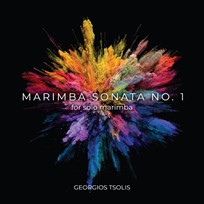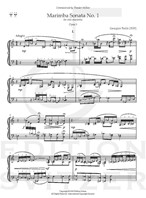
Marimba Sonata No. 1
Composer: Georgios Tsolis
Instrument: Marimba
Level: Advanced
Published: 2020
Price: €35.00
Item details
-
Description +
-
Duration: approx. 20 min.
Commisioned by Theodor Milkov
With support from Koda’s Cultural Funds
Preface
In 2020, Georgios Tsolis made his debut as a composer into the world of contemporary classical music, composing his first sonata for solo marimba. Marimba Sonata No. 1 was commissioned by Theodor Milkov, one of the most innovative and prominent marimba soloist in the world. This work is the 1st part of 4 sonatas under the title “Portraits in Modern”, the result of close collaboration of Georgios and Theodor. A set of works that aim to explore the possibilities of this instrument and at the same time incorporates the composer’s influences from jazz to classical, and from traditional Greek music to free improvisation as coexistence within classical forms used for centuries by the great masters.
Georgios attempts to create an adventurous harmonic and melodicenvironment leading to the development of his own sound and language. His idea of harmony and melody deriving from his experience in improvisation and his musical influences is premiered in this 1st sonata. “Tailored” to the extraordinary performing skills of Theodor Milkov, a carpet of virtuosic passages emerges from a surprising harmonic development, a narrative changing of characters and moments of melodic release come together to tell its own stories and at the same time pushes the possibilities of this instrument to its limits.
-
-
Instrumentation +
-
Marimba (5 octave)
-
-
Watch+
-
Performed by Theodor Milkov
-
-
About the composer +
-
Born and raised in Kefalonia, Ionian Islands, Greek pianist and composer Georgios Tsolis currently resides in the Hague, the Netherlands since 2004. Studied at the Royal Conservatory of the Hague where he gained his bachelor and masters in jazz piano performance. Emerging from the jazz scene as an established musician, he has been active for the last 15 years with appearances in various festivals and locations around Europe, receiving excellent reviews for his work both as a composer and performer.
Composition has always been the key element and life companion in his musical journey. “Daring to diverge” is an expression of creativity for him. A constant quest for oneself as the key to continuous progress and development is a view of life and music is his vehicle to this quest. He composed music for solo piano, jazz trios, quartets, big band and orchestra. Lately he is debuting as a composer into the world of contemporary classical music with a series of sonatas for solo marimba and many more to come.
As a composer, he has the tendency to experiment with the expansion of the harmonic and melodic language within traditional forms. His musical influences from jazz and improvisation, to Greek traditional music and classical, is incorporate into his music; a coexistence and guide on the way to the development of his own sound and language.
-
-
Reviews +
-
Review (Percussive Notes, October 2021)Georgios Tsolis has contributed this work to the lexicon of virtuosic marimba music. Throughout the three movements, the player must traverse complex harmonic movement, quick single-hand gestures, and written-out improvisation in a piece that requires the highest levels of dexterity.The first movement is in a classic ABA´ form. The first A section can be characterized as being the most rhythmically and harmonically complex. Much of this section is a series of thirtysecond- note gestures that cruise up and down the instrument, and brief musical ideas that sequence nicely into the next idea. This section ends with a brief, groovy portion that still utilizes complex rhythmic ideas and quick riffs, but in a manner that does not feel like the marimbist is flexing his or her dexterity muscles. The B section is the most lyrical. It is composed mostly of singable legato melodies with an alberti-esque left-hand accompaniment that is pleasant to listen to. The A´ section is a reduction of the beginning portion, using much fewer cruising gestures, and still making best use of the groovy portion near the end. The movement ends with a final cruise up and down the marimba in thirty-second notes, landing forcefully on four octaves of F-naturals.The second movement is the shortest of the three by a significant margin and much more lyrical. Here, a motif is developed and varied several times. The density of notes gradually increases with each variation until the page is black with thirty-second notes, with appropriately placed accents to help denote where the melody still exists. Each variation is well constructed and developed in an organic way that sounds almost improvisatory at times.The last movement returns to a ternary form. The outside sections are, like the first movement, a series of brisk sixteenth-note gestures in the right hand with a more direct eighth-note accompaniment in the left. While no specific melody stands out among these bursts of notes, each ends with a motif played in perfect octaves between the hands, which is used as a cadential arrival. The middle section features a repeated bass line in the left hand and a right-hand part that sounds like a well-transcribed improvisation. The piece ends with an extended version of the cadential octave figure and finishes strongly on four octaves of D-natural.This piece is technically very difficult. In all three movements, the performer is required to play incredibly quick gestures or melodies with only the two mallets of the right hand while the left plays harmonic accompaniment that can sometimes be complex. This can easily be compared to piano music that has distinct right-hand and left-hand parts. This is not impossible, and when done appropriately it makes for an impressive performance of contemporary marimba playing. However, it is only for the most seasoned marimbists among us.—Kyle Cherwinski
-
-
Credits +
-
Front Cover graphics and layout: Ronni Kot Wenzell
Photo: YIannis Lostopoulos
Engraving: Ary Golomb
Printed in Copenhagen, Denmark
Copyright © Edition SVITZER
www.editionsvitzer.com
-




